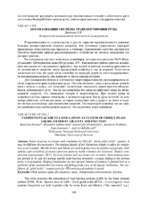| dc.contributor.author | Dounar, S. | ru |
| dc.contributor.author | Iakimovitch, A. | ru |
| dc.contributor.author | Mishchanka, K. | ru |
| dc.contributor.author | Penkina, A. | ru |
| dc.contributor.author | Lavrenov, E. | ru |
| dc.contributor.author | Jakubowski, A. | ru |
| dc.coverage.spatial | Минск | ru |
| dc.date.accessioned | 2020-06-08T06:56:45Z | |
| dc.date.available | 2020-06-08T06:56:45Z | |
| dc.date.issued | 2019 | |
| dc.identifier.citation | Parthenon faсade fea simulation as system of freely piled solids joined by gravity and friction / S. Dounar, A. Iakimovitch [и др.] // Новые горизонты - 2019 : сборник материалов Белорусско-Китайского молодежного инновационного форума, Минск, 12–13 ноября 2019 г. / Белорусский национальный технический университет. – Минск : БНТУ, 2019. – С. 106-108. | ru |
| dc.identifier.uri | https://rep.bntu.by/handle/data/73462 | |
| dc.description.abstract | Paper concerns to contact task simulation by FEA for “freely piled solids” systems. It may be different dry masonries. The antique façade of the Parthenon temple is taken for simulation as an example. Marble drums and blocks are held together only by friction and gravity. Multiplicity and variability of contact pressure patterns inside columns are disclosed. Surface compression concentrators (SCC) between echinus and top drums are revealed. Such concentrators are proved to be safe for antique marble load-bearing structures. Contact sliding in the column joints is investigated. Slipping localization on the top and bottom of columns is pointed out as a predictor of the uncontrolled movement and falling in the case of the façade inclination. The usefulness of „piled solids” contact tasks for FEA-training of students is stated. | ru |
| dc.language.iso | ru | ru |
| dc.publisher | БНТУ | ru |
| dc.title | Parthenon faсade fea simulation as system of freely piled solids joined by gravity and friction | ru |
| dc.type | Working Paper | ru |

